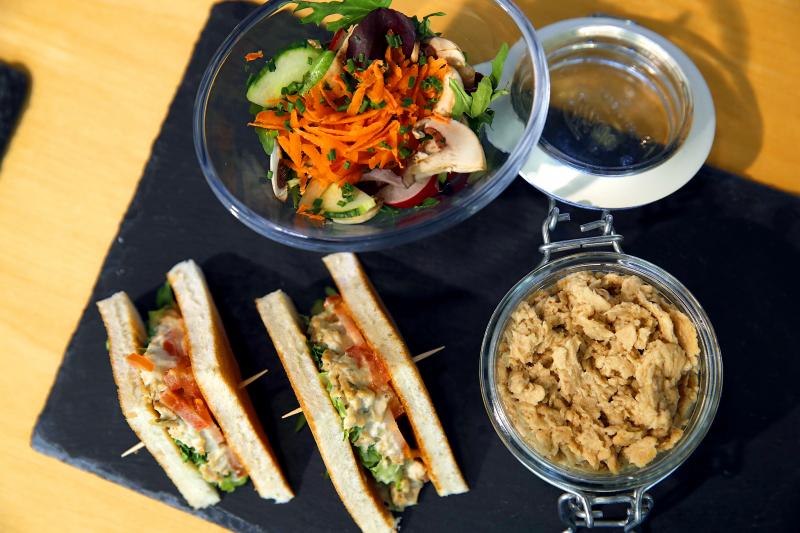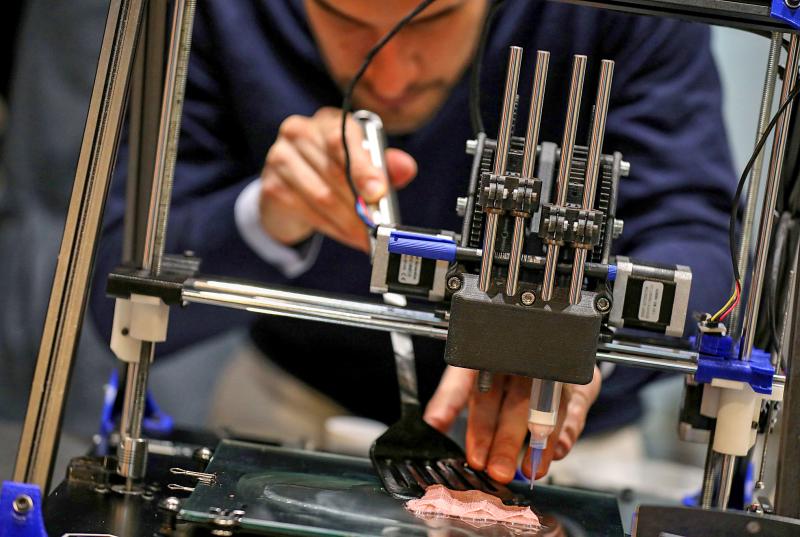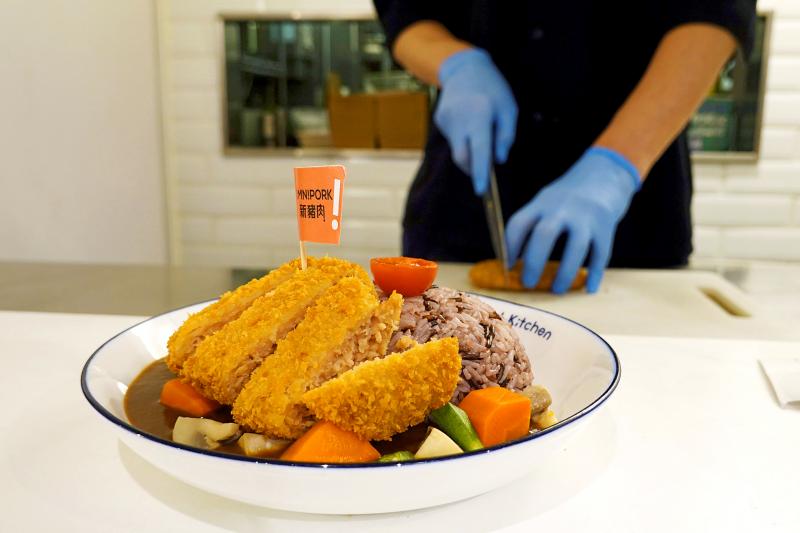Every January, the British food media attempts to predict which ingredients and dishes will define the next 12 months. A new year means new food and magazine tip-lists of cool ingredients. It is traditional. This inexact science, a blend of research, intuition, wishful thinking and cribbed retailer data might, depending on your point of view, seem either harmless or ridiculous. But it has been lucrative for those selling craft gin, pulled pork, acai berries, gochujang, pastry stouts or any of 101 items that in the past decade have found themselves hailed as The Next Big Thing.
Such renewal is human nature, says Daniel Woolfson, food and drink editor at trade magazine The Grocer.
“People are faddy. When Instagrammable stuff gets old, they instinctively look for the next thing.” But how? Where? Can the public create trends, in its likes and retweets? Or are we always manipulated by “big food?”

Photo: Bloomberg
DISRUPTION
“The industry is obsessed with disruption,” says Woolfson. That is, creating a new sub-group in a food or drink category or transforming how an item is perceived and sold. Fever-Tree is the classic example. It pioneered an unforeseen market for “posh tonic” and even now when, like kombucha, cupcakes, Brewdog or smashed-patty burgers, it is long past peak cool, it retains an aura of quality and sophistication that bolsters sales. In 2014, nine years after its launch, the company was floated on the stock market, valued at £154 million (US$208.5 million). It is now worth considerably more.
“Difference sells,” says Perry Haydn Taylor, founder of the branding consultancy, Big Fish. “Like dogs, foodies wag their tails at the slightest sniff of new and exciting. Then bark at each other on social media. Food is fashion. If you’re into that stuff, it matters.”

Photo: Reuters
“Brands getting that hip cult following are the ones that allow consumers to be invested advocates in what they’re about,” says Fiona Beauchamp of marketing agency Bray Leino. Instagram appears to be the perfect forum for such organic conversation. According to Facebook IQ, food and drink is UK Instagram’s most popular topic: 39 percent of users consider themselves “food aficionados.”
The reality, says Miguel Barclay, known for his Instagrammable “one pound meals,” is a manic scramble to get eyeballs-on-product using freebies and paid posts. “Vegan companies are on a whole new level. They find anyone who ever used the hashtag vegan, build up a network of 200 influencers and bombard them with free gifts. I work with very few brands. But most people [on Instagram] promote stuff all the time and don’t care what it is.”
With his 300,000 followers and bestselling cookbooks, Barclay is among an elite of Instagram faces who can pull a “five-figure sum, easily” as brand ambassadors. Such gigs, fronting and developing recipe content for well-known companies “are more subtle, useful and classic.”

Photo: Reuters
Barclay would say that. He may be right, too. As owner of Sous Chef, an online retailer of specialist ingredients, Nicola Lando is permanently scanning the horizon for the next kefir or kimchi, everywhere from trade fairs to the US media. She refuses to identify a fixed hierarchy of influence but says the endorsement of authoritative chefs and cookery writers still matters. The resulting online chatter confirms the agenda, rather than setting it.
“What drives UK food trends is people seeing interesting ingredients on restaurant menus, taking photos and sharing dishes,” she says.
“Products are seen as premium if chefs use them,” agrees Stefan Chomka, the editor of Restaurant Magazine. “And, recently, many trends — barbecue, kimchi, bao buns — have come from restaurants. Supermarkets watch what’s happening there.”
DATA AND PR
When choosing to list fashionable ingredients, the supermarkets’ analysis goes far deeper. Waitrose’s executive chef Martyn Lee, who leads the store’s product development, tracked guanciale’s growing popularity through modern Italian cookbooks and restaurants such as Polpo and Padella, but Waitrose only opted to stock it in October after “data-driven” reports from its social media and web teams confirmed cured pig’s cheek was in demand nationally. “You need multiple instances of something coming through to join the dots,” says Lee. “We spot trends by them appearing in different spaces.”
How that buzz is generated differs enormously depending on aim, budget and luck. Are you shooting for supermarket ubiquity or locking in a loyal cult following? Given how consumers crave validation, you will usually need bartenders, baristas, bloggers, food journalists and other trusted figures (even key, high-quality Instagram influencers) on your side, talking you up.
Ever wondered how avocados became ubiquitous? Two decades of preparatory work by the London PR agency Richmond & Towers helped. In 1995 it began to act for the South African Avocado Growers Association, taking journalists to South Africa, using chefs, health and lifestyle ambassadors to boost the fruit’s profile, and producing in-store sales material and recipe booklets. Back then the task was straightforward: teach anyone unfamiliar with the fruit how to eat it.
Around that time UK avocado sales were worth £13 million annually. By 2016 that figure had shot up to £150 million. There was an element of good fortune here. Fashion is always contingent — in the avocado’s case on the rise of the “wellness” industry, so-called superfoods and social media’s foregrounding of all things photogenic. Nonetheless, it is difficult to begrudge Richmond & Towers claiming this 18-year campaign (which ended in 2013 and cost about £2.5 million) as “the most successful fresh produce campaign in UK history.”
Will COVID-19 nip such frivolity in the bud? Slow the trends cycle? Not likely. Retailers report a significant shift to comfort foods. The economy is shot. The fashions that this new environment might spawn may feel less glib. But those trends (a focus on craft and utility in food, cementing the home-baking craze, perhaps a post-Brexit run on British heritage ingredients) may still be the ones that foodies lap up.
There is a growing ethical objection to the damage this greedy churn creates. Global trade in hyped ingredients can cause ecological and social fallout, such as price spikes in countries where the products originate from. In 2017, after a poor harvest of avocados, reports blamed global demand for making this once staple food too expensive for many ordinary Mexicans.
The way such ingredients are frequently sold in Britain, as “new” and “exotic,” ignoring their status in some communities or long culinary histories, is also increasingly being recognized. For instance, given the media coverage you’d be forgiven for thinking jackfruit was invented as a meat substitute in Dalston in 2017 rather than something used in savory south and south-east Asian dishes for aeons.
“When a food gets popular, I want to see the people who kept those recipes and food cultures alive for generations, not someone who ‘discovered’ it on holiday, nor giant companies who pillage lands, giving nothing back financially, culturally or ecologically,” says Riaz Phillips, author of Belly Full: Caribbean Food in the UK.
Similarly, Lap-Fai Lee, a professional cook and tutor in Birmingham, finds chefs putting their “twist” on east and south-east Asian foods “laughable, juvenile, mildly racist. No western chef would put basil in carbonara, but they happily ‘reinterpret’ XO sauce. Next, it’ll be kosho, nam jim, sambal.”

In the March 9 edition of the Taipei Times a piece by Ninon Godefroy ran with the headine “The quiet, gentle rhythm of Taiwan.” It started with the line “Taiwan is a small, humble place. There is no Eiffel Tower, no pyramids — no singular attraction that draws the world’s attention.” I laughed out loud at that. This was out of no disrespect for the author or the piece, which made some interesting analogies and good points about how both Din Tai Fung’s and Taiwan Semiconductor Manufacturing Co’s (TSMC, 台積電) meticulous attention to detail and quality are not quite up to

April 21 to April 27 Hsieh Er’s (謝娥) political fortunes were rising fast after she got out of jail and joined the Chinese Nationalist Party (KMT) in December 1945. Not only did she hold key positions in various committees, she was elected the only woman on the Taipei City Council and headed to Nanjing in 1946 as the sole Taiwanese female representative to the National Constituent Assembly. With the support of first lady Soong May-ling (宋美齡), she started the Taipei Women’s Association and Taiwan Provincial Women’s Association, where she

It is one of the more remarkable facts of Taiwan history that it was never occupied or claimed by any of the numerous kingdoms of southern China — Han or otherwise — that lay just across the water from it. None of their brilliant ministers ever discovered that Taiwan was a “core interest” of the state whose annexation was “inevitable.” As Paul Kua notes in an excellent monograph laying out how the Portuguese gave Taiwan the name “Formosa,” the first Europeans to express an interest in occupying Taiwan were the Spanish. Tonio Andrade in his seminal work, How Taiwan Became Chinese,

Mongolian influencer Anudari Daarya looks effortlessly glamorous and carefree in her social media posts — but the classically trained pianist’s road to acceptance as a transgender artist has been anything but easy. She is one of a growing number of Mongolian LGBTQ youth challenging stereotypes and fighting for acceptance through media representation in the socially conservative country. LGBTQ Mongolians often hide their identities from their employers and colleagues for fear of discrimination, with a survey by the non-profit LGBT Centre Mongolia showing that only 20 percent of people felt comfortable coming out at work. Daarya, 25, said she has faced discrimination since she